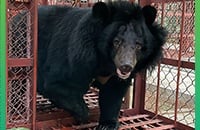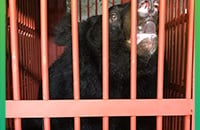The rise of the captive wild animal entertainment industry in Vietnam
23 February 2016
Reports suggest all is not well at the new safari park on Vietnam’s Phu Quoc – Animals Asia Animal Welfare Director Dave Neale looks at what may have gone wrong and how Vietnam needs to start to put animal care before commerce.
The desire to keep wild animals in captivity for entertainment is not a new concept in Vietnam. Saigon Zoo opened its doors in 1865, and since then a number of zoos and animal attractions have developed. In recent years Vietnam has moved towards the development of captive dolphin facilities and the establishment of larger safari parks.
In January 2016, the hugely successful Vinpearl company announced the opening of a new safari park on Phu Quoc island. The Vinpearl website describes the safari park as a “sanctuary” which is home to 400 species of plants, and 2,000 wild animals representing 140 different species, many of which are considered rare and endangered. News reports quote the parks director stating that the company aims for the park to be a wildlife conservation programme and zoo of international standard in Vietnam and an example to other developments across Asia. The Phu Quoc safari park is the second “captive wild animal” venture developed by Vinpearl, the first being the development of a dolphinarium as part of the Vinpearl Land resort in Nha Trang.
The company paints an idyllic picture of happy animals living within a peaceful setting with their needs being met. Yet within one month of the park opening, as yet unconfirmed reports suggest, the reality on the ground appears to be anything but idyllic.
A February 15 blog post alleges deaths at the park. While it should be clear that these claims are not, as yet, backed up by first hand accounts and have, in part, been denied by the park owners. The report suggests alleged fatalities are attributed to parasites, disease, underfeeding and horrific accidents, with capture myopathy also being suggested. There are no details available on where these animals are sourced from which is also a matter for concern.
There have also been suggestions that animals have escaped from the park into the island environment.
When you ask how could this happen – the old adage of “follow the money” is a fair response. Beyond the cruelty involved with wild caught captive animals at the outset – there is the suggestion that this is all too much, too soon. The developers appear to have pushed the development towards an opening date when it seems as yet unprepared to provide a suitable environment for the many imported animals.
Such rapid and damaging expansion is likely to continue with news of more safari park developments already in the planning stage within the country, and if these developments are being led by companies and individuals that put profit before welfare, conservation and education, the animals will often be regarded as disposable commodities which can be easily replaced.
At Animals Asia we are trying to stem this trend. Working with individuals within the Vietnamese zoo industry that want to see welfare, conservation and education prioritised over entertainment, we have developed a dialogue with the national government which is seeing the development of Vietnam’s first ever “animal welfare standards’ for zoos and safari parks. If these standards are adopted by the government and enforced by the provincial authorities, they have the potential to turn the tide on this wider situation.
Zoo operators would be legally bound to make the welfare of animals their top priority and animal transactions, disease incidence, and deaths would be tightly monitored. Establishments would be punished for poor management and risk not being able to operate as public facilities if poor management and high numbers of animal deaths persist.
The adoption of these standards still has a long way to go but they provide the hope that is needed to end the current downward spiral that is seeing animals being used and in many cases abused for entertainment.
But for the time being, with few standards in place to regulate facilities displaying captive wild animals in Vietnam, these animals’ lives are in the hands of commercial enterprises, breeders and exporters that seem willing to put profit before the lives of individuals, and inexperienced animal managers who apparently do not possess the knowledge and skills to care for the animals that they are receiving.
Whilst this remains the case, I am afraid the situation may get worse before it gets better.
BACK







 Freedom after two decades: Moon bears Nang and Mua rescued
Freedom after two decades: Moon bears Nang and Mua rescued
 With heavy hearts we say goodbye to our beloved Tulip
With heavy hearts we say goodbye to our beloved Tulip
 Three moon bears rescued from notorious bear bile farming hotspots in Vietnam
Three moon bears rescued from notorious bear bile farming hotspots in Vietnam
